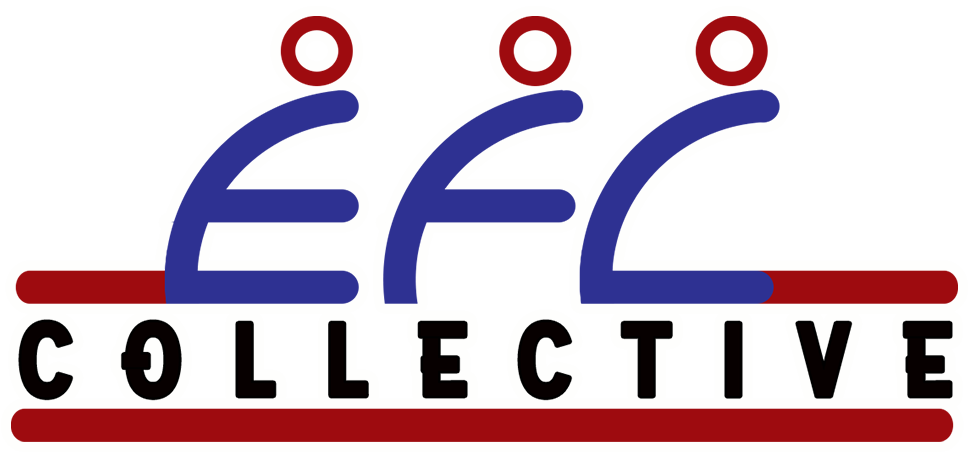
EFL Collective
Your Prime Resource for FREE Practical and Economical EFL/ESL Worksheets and Materials
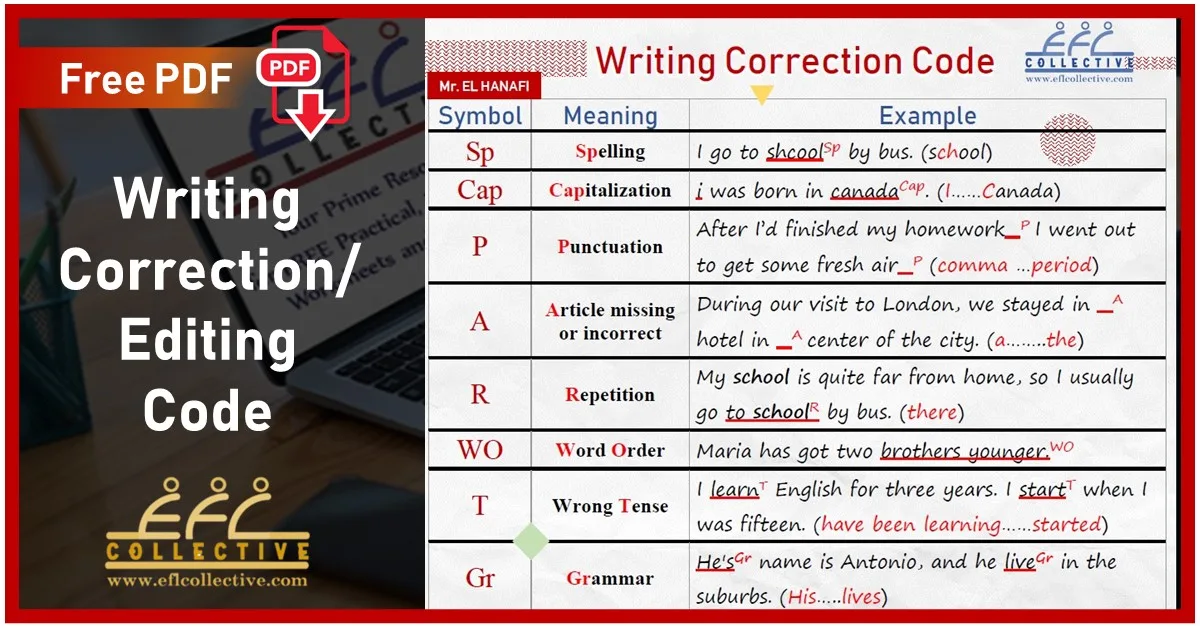

A Must-have Poster: Writing Correction Code
Language teachers sometimes have the tendency of providing edits when checking students’ pieces of writing. Because students’ mistakes in writing can sometimes be “provoking” in a way, language teachers are tempted to provide corrections instead of eliciting them. However, by providing edits, teachers can never be certain that students will not make the same mistakes again. It is with hints teachers suggest through writing editing codes that learners can initiate some self-correction, which is one of the key elements in learning writing skills. Moreover, self-correction instils autonomy in students, and, by extension, they will likely make fewer mistakes.
A writing correction/editing code is a set of rules and symbols that instructors can use to assess students’ pieces of writing in order to elicit corrections rather than provide them. Using correction codes is considerably effective in teaching ESL/EFL writing. MacDonald (2020 ) investigated the effectiveness of different writing corrective feedback strategies on L2 writing accuracy and analysed the findings of 14 studies which incorporated correction codes. He suggested that correction codes have a more significant positive impact on long-term writing accuracy compared to direct writing corrective feedback. What is more, writing codes can “promote additional reflection and higher-level thinking for learners.”
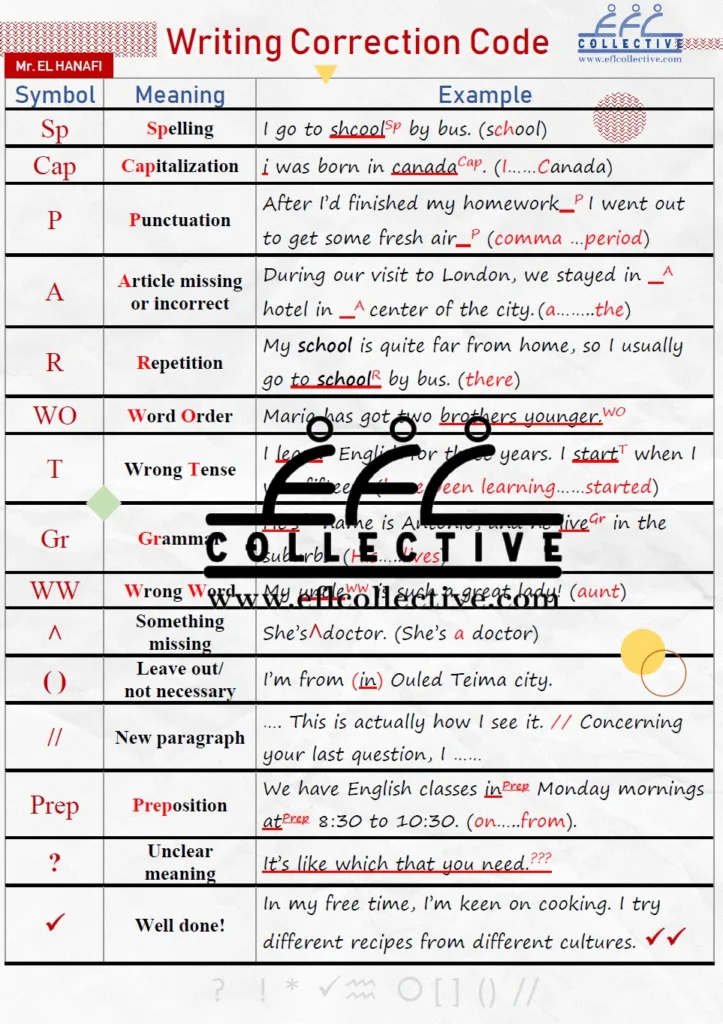
Before you start using the writing code symbols for feedback, your students should first be supervised in class so that they fully understand what is expected of them. As such, we suggest that you keep your writing correction code on a poster or print it in a form of handouts for your students. Alternatively, students can copy it somewhere on their notebooks for reference.
It is also recommended that you confine your feedback only to what your students have learned in writing classes. As you advance in the course, you can include more elements until you gradually cover them all. For instance, at the outset of the course, you can only focus on capitalization, spelling, and some grammatical mistakes. Later on, you can indicate verb-subject-agreement mistakes, etc.
- EFL Collective Writing Correction Code
- British Council Suggested Writing Code
Related Posts

Comments (4) on “A Must-have Poster: Writing Correction Code”
Very useful and practical. Many thanks Sir. Mourad El Hanafi
Thank you so much, Si Imam. We’re glad you liked it ☺️
Jazaka Allahu khair. This is very useful.
It is pleasure to serve you, dear colleague. Wa jazak 🤲
Leave a Reply Cancel reply
Your email address will not be published. Required fields are marked *
Save my name, email, and website in this browser for the next time I comment.
elttguide.com
- Premium Content
- Publications
- Lesson Plans

The Most Useful 10 Symbols To Use For Correcting Students’ Writing

Correcting errors and giving feedback on writing can be tricky. If you correct everything, there is a danger of covering the work in comments and ‘red ink’. This can be both demotivating and unhelpful because the students either give up or they just write out the piece again with all your corrections inserted. Alternatively, if you decide to focus only on certain errors or give feedback only on certain parts of their work, the students will wonder at a later stage why you didn’t highlight all the mistakes to begin with.
One way to help them is to develop a correction code. This is a series of symbols that you use to indicate errors.
Write the symbol above the error so that the students have to think about what the mistake is rather than simply read your correction of it. So a sentence in an essay might look like this:
C WW WO SP
John was very sensible and didn’t take well critisism.
The symbols above indicate that the sentence needs a capital letter (C), sensible is the wrong word (WW) (having been confused with sensitive), the word order (WO) of well criticism should be criticism well and there’s a spelling mistake (SP) in the final word.
Having to find their own mistakes like this creates a greater challenge for the students.
Note: If you are marking computer-written texts, the same principles apply. However, you can insert your comments using different coloured fonts or use the comments function, which creates small boxes in the margin of the text with a space to give feedback.
Here are the most useful 10 symbols you could put on your students’ writing in order to help them notice their mistakes.
This indicates a spelling mistake in a word.
If students write words in the wrong order, such as an adjective after a noun ( house big instead of big house ), write WO to indicate the problem.
You can write P to let your students know there is a punctuation problem.
When students make a mistake with verb tense, you can write a T above the verb. In the following example, the student has used the present perfect when the tense should be the past simple:
I’ve started work here in 2001.
“Wrong word,” tells the student they need to replace a word because it doesn’t have the right meaning.
This indicates a missing word in the sentence and usually, you put it under the sentence or inserted it between the two words where a word is missing, like this:
I’m interested “ learning more about English.
As well as missing a word, students sometimes add an extra incorrect word. You can use the square bracket symbol around the incorrect word or above it, like this:
All you need is [the] love.
WF stands for an incorrect word form. For example, perhaps a student has written the adjective form instead of an adverb (e.g. I ran quick ) or the verb form instead of a noun (e.g. Let me give you some advise ).
If a student has turned one word into two words, then connect them with this curved line, like this:
‘I can’t see them any~where!’ Gavin said.
Sometimes students will run one sentence into another, so you want to indicate that they should create two separate sentences. Use a backslash symbol, like this:
We walked for over an hour / suddenly there was a loud crashing sound!
In longer pieces of writing, you can also indicate that the essay writer needs to start a new paragraph. Many teachers write double lines (//) at the end of a sentence to show that the next sentence should be the start of the next paragraph.
Most of the previous symbols are fairly standard in English language teaching, though you will come across others. The important thing is that you should be consistent with your symbols when marking your students’ work. It’s a good idea to give them a brief guide to your marking symbols at the beginning of a course so that they are familiar with the symbols you are using.
Thanks for Reading
Like this article?
Share it with your network.
You can also join my email list not only to be notified of the latest updates on elttguide.com but also to get TWO of my products : Quick-Start Guide To Teaching Listening In The Classroom & Quick-Start Guide To Teaching Grammar In The Classroom For FREE!
Join My Email List Now (It’s FREE)!
Want to continue your elt professional development.
I offer various ELT publications on teaching English as a foreign language.
In these publications, I put the gist of my experience in TEFL for +20 years with various learners and in various environments and cultures.
The techniques and tips in these publications are sure-fire teaching methods that worked for me well and they can work for you, as well, FOR SURE.
Go ahead and get a look at these publications to know more about each one of them and the problem & challenge each one focuses on to overcome.
Then, you can get what you have an interest in. It is very easy and cheap. You can afford it and you’ll never regret it if you decide to get one of them, FOR SURE.
Now, click to get a look at my Publications
If you like it, share it on:.
Very interesting and very timely during this pandemic era.I would pitch this to my school principal for Learn]ng Action Cell session among lanuage teachers to have a unifor writing assessment tool.
Leave a Reply Cancel reply
You must be logged in to post a comment.
Subscribe to My Newsletter
Affiliate disclosure.
This website might have affiliate links, and if you buy something by clicking on them, the website owner could earn some money. To learn more, read the full disclosure.

Study TEFL/TESOL Online

Get 15% Discount

Visit My Video Channel

Articles Categories
- Back To School
- Brain-based ELT
- Classroom Management
- CLT Communicative Language Teaching
- Correcting Mistakes
- Develop Students' Speaking Skills
- Developing Critical Thinking
- Developing Life Skills
- ELT Snippets
- ELTT Questions & Answers
- For IELTS Exam
- Guest Posts
- Job Interview Preparation
- Lanaguage Teaching Approaches
- Learning How to Learn
- Lesson Planning
- Low Achiever Students
- Online Courses
- Printables Library
- Professional Development
- Talk on Supervision
- Teach Conversations
- Teach Grammar
- Teach Language Functions
- Teach Listening Activities
- Teach Pronunciation
- Teach Reading
- Teach Vocabulary
- Teach Writing
- Teacher Wellness
- Teaching Aids
- TEFL Essential Skills
- TEFL to Young Learners
- Testing and Assessment
- The ELT Insider
- Uncategorized
- Using Technology in EFL Classes

- Memberships
- Institutional Members
- Teacher Members

Error Correction
This page includes a standard error correction symbol code. Use these symbols to highlight key mistakes in a student’s work.
This is a 3-way system .
1) Tutor marks the mistakes using the correction code and returns to the student.
2) Student makes correction in a different colour pen and returns to the tutor.
3) Tutor checks the corrections and returns to the student.
Reason: This way the student learns from their mistakes and takes more responsibility in correcting errors and learning from mistakes.
Error Correction sheet
√ = good point / good idea
√√ = very good point
? = confusing
^ = missing word
Gr = Grammar
A = Article (a, an, the, /)
WW = Wrong Word
WF = Wrong form
Coll = Collocation
W/O = Word Order
Inf = informal
Prep = Preposition
P = Punctuation
R = repetition
Sp = Spelling
RC = Relative clause (which, that, who etc..)
Ref = in-text reference problem
Cau = caution (too strong – soften with could, may, might, appears, possibly)

online resources

Medical English

New for 2024

DropBox Files
Members only

Instant Lessons

OneDrive Files

Topic-lessons

Feedback Forms

6-Week Course

SPSE Essays

Free Resources

Charts and graphs

AEUK The Blog

12-Week Course
Advertisement:.


EASTER SALE 20% off
Offer ends April 7th 2024
Take me there
You have Successfully Subscribed!

- € 0.00 0 items
Writing correction code
Use the following symbols to understand the mistakes you have in your writing and to help you correct the mistakes yourself. Sometimes you won’t know the correct form, so ask your teacher if you’re not sure.
SYMBOL – MEANING S – Incorrect spelling WO – Wrong word order T – Wrong tense A – Something doesn’t agree (subject -verb/ article-noun etc.) WF – Wrong form S/P – Singular or plural form wrong ˄ – Something has been left out [ ] – Something is not necessary ?M – Meaning is not clear NA – The usage is not appropriate (too formal / too informal) P – Punctuation wrong G – Grammar WW – Wrong Word
- Click to share on Facebook (Opens in new window)
- Click to share on Twitter (Opens in new window)
- Click to share on LinkedIn (Opens in new window)
- Click to email a link to a friend (Opens in new window)
- Click to share on Pocket (Opens in new window)
- Click to share on Pinterest (Opens in new window)
- Click to print (Opens in new window)
- A post-COVID-19 Airbus
- Video answers: Air Cargo’s Coronavirus Problem
- Video: Air Cargo’s Coronavirus Problem
- Structure: ‘Direct and indirect objects’
- Flying cargo in passenger compartments

1.2 GETTING STARTED: Using Correction Codes

1. If you see an correction code with just a question mark (?), what should you do?
- Rewrite the sentence another way.
- Ask the teacher a question.
- Change the sentence into a question.
2. What does the code “ART” mean?
- You have a mistake involving a, an, the or zero article.
- Your writing is too artsy.
- You should refer to the American Rhetoric Text for help.
3. Which sentence is an example of an S-V error?
- The child eat candy every day.
- The dog ran in the park.
- The man works at a bank.
4. What error code might you give the following sentence? The water flowed quickerly over the river banks and flooded the town.
5. What does the code “SP” mean?
- Be specific.
- Check spelling.
- It’s special.
6. Identify the error in this sentence: So many students study English classes at Portland Community College are not always easy.
- It is a comma splice. A coordinating conjunction should be added to separate the independent clauses.
- It is a fragment. It is not a complete sentence.
- It is a run-on sentence. Punctuation should be added to separate the independent clauses.
- There is no error in the sentence.
7. What does the code “PRO” mean?
- professional
8. Which error code would apply to the following sentence: You can do tonight, the homework?
9. What does the code “C/S” mean?
- Good point; the teacher can see what you mean.
- You should add a comma to your sentence.
- Your sentence has a comma splice.
10. The following sentence has a FRAG error: Many students happy about spring in Portland. What does FRAG mean?
- FRAG stands for fully recognized and graded; this means that the sentence is understandable, but not perfect, so it will receive a lower grade.
- FRAG means fragment, or only a part of something, not the whole thing. So this is not a complete sentence. It is missing either a subject or a verb, or it does not express a complete idea.
- FRAG means “fragile”. In other words, this sentence has a good idea, but it is not written well. It needs to be stronger.
Synthesis Copyright © 2022 by Timothy Krause is licensed under a Creative Commons Attribution-NonCommercial-ShareAlike 4.0 International License , except where otherwise noted.

Understanding YDS – Your Gateway to English Proficiency in Turkey

TOEFL – Your Guide to Global Academic Success

Navigating the PTE – Your Pathway to English Proficiency

EAL: English as an Additional Language

Business English Program – Transform Your Professional Communication

Mastering IELTS – Your Guide to Global English Proficiency
Faster English July 6, 2023
Correction codes are standardized symbols or abbreviations used to indicate and rectify specific types of errors in written text. They provide a concise and efficient way to identify and address mistakes, allowing writers to improve the accuracy and clarity of their work.
These codes are important for several reasons:
Precision: Correction codes enable precise identification of errors by categorizing them according to their type. Instead of providing lengthy explanations or rewriting entire sentences, codes offer a shorthand method to pinpoint specific areas that require attention. This precision saves time and effort, making the editing process more efficient.
Consistency: Correction codes provide a consistent and standardized approach to error identification and correction. By adhering to a set of established codes, writers and editors can communicate and understand errors in a uniform manner. This promotes clarity and ensures that corrections are made consistently throughout a piece of writing.
Efficiency: With correction codes, the editing process becomes streamlined. Writers can quickly identify the specific type of error without getting caught up in lengthy explanations. This allows them to focus on making the necessary corrections promptly, enhancing the overall efficiency of the editing and revision process.
Focus on Specific Errors: Correction codes help writers focus on specific areas of improvement. By highlighting different types of errors, such as spelling, grammar, punctuation, or word choice, the codes guide writers to target their attention on particular aspects that require correction. This targeted approach ensures a thorough review and reduces the likelihood of overlooking errors.
Learning Tool: Correction codes serve as educational tools, helping writers identify recurring mistakes and learn from them. By using the codes consistently, writers can track their progress over time, recognizing patterns in their errors and taking steps to improve their writing skills. The codes provide a framework for self-improvement and ongoing development as a writer.
In English, there are several correction codes used to indicate and rectify errors. Here is a list of commonly used correction codes in English:
SP: means Spelling Error – This code is used to indicate a spelling mistake in a word.
^: means A word or letter is missing: This code is used to indicate that a word or letter is missing.
GR means Grammar Error – This code is used to highlight a grammatical error in a sentence.
P means Punctuation Error – This code is used to identify a mistake in punctuation usage, such as missing or incorrect punctuation marks.
CS means Capitalization Error – This code indicates an error in the capitalization of words, such as using lowercase letters for proper nouns or starting a sentence with a lowercase letter.
VT means Verb Tense Error – This code is used to point out errors in verb tense consistency or incorrect verb usage.
WC means Word Choice Error – This code indicates an incorrect or inappropriate word choice in a sentence.
SV means Subject / Verb agreement error. This code indicates an error in subject/verb agreement within a sentence.
AWK means Awkward Phrasing – This code is used when a sentence or phrase is poorly constructed or awkwardly worded.
RO means Run-On Sentence – This code is used to identify a sentence that lacks appropriate punctuation, resulting in two or more independent clauses joined together without proper separation.
FRAG means Sentence Fragment – This code indicates a sentence that is incomplete or lacks a subject, verb, or both.
MOD means Modifier Error – This code is used to highlight errors in the use of modifiers, such as misplaced or dangling modifiers.
COH means Lack of Coherence – This code is used to indicate a lack of logical or cohesive connection between sentences or paragraphs.
Sign Up for FREE Today!
Sign up for FREE now and take the first step towards unlocking your English language potential!

We take pride in our students’ success stories, and we are committed to empowering adult migrants to become confident English speakers.
Latest Posts

How to Learn English Faster: 7 Proven Tips for Rapid Progress

Understanding Gerunds and Infinitives: A Simple Guide
© 2023 Faster English | All Rights Reserved
There was a problem reporting this post.
Block Member?
Please confirm you want to block this member.
You will no longer be able to:
- See blocked member's posts
- Mention this member in posts
- Invite this member to groups
- Message this member
Please allow a few minutes for this process to complete.
Proofreaders' and Teachers' Correction Marks
Dmitry Volkov/Getty Images
- Homework Tips
- Learning Styles & Skills
- Study Methods
- Time Management
- Private School
- College Admissions
- College Life
- Graduate School
- Business School
- Distance Learning
- M.Ed., Education Administration, University of Georgia
- B.A., History, Armstrong State University
Confused about the teacher's squiggly marks on your paper? This list of correction marks includes the most common proofreader marks you'll see on your paper drafts. Be sure to make these corrections before turning in your final draft.
Grace Fleming
The "sp" on your paper means there is a spelling error. Check your spelling, and don't forget about commonly confused words . These are words like effect and affect that your spell check won't catch.
Capitalization
If you see this notation on your paper, you have a capitalization error. Check to see if you have put the first letter of a proper noun in lower case. It's a good idea to read over a guide to capitalization rules if you see this mark often.
Awkward Phrase
Grace Fleming
The "awk" indicates a passage that seems clunky and awkward. If the teacher marks a passage as awkward, you know that they stumbled over your words during their review and became confused about your meaning. In the next draft of your paper, be sure to rework the phrase for clarity.
Insert Apostrophe
Grace Fleming
You will see this mark if you've omitted a necessary apostrophe. This is another mistake that the spell checker won't catch. Review the rules for apostrophe use and revise your paper accordingly.
Insert Comma
The teacher will use this mark to indicate that you should insert a comma between two words. Comma rules can be quite tricky, so it's important to review the rules of comma usage before you submit your final draft.
Begin New Paragraph
This mark indicates that you need to begin a new paragraph in a certain location. When you revise your paper, be sure to rework your format so that you begin a new paragraph each time you complete one point or thought and begin a new one.
Remove Paragraph
Sometimes we make the mistake of starting a new paragraph before we complete our message or point. Teachers will use this mark to indicate that you should not start a new paragraph at a particular point. If you are having difficulty with how to divide your paper correctly, it might be helpful to read over some tips for writing effective transition sentences .
The "delete" symbol is used to indicate that a character, word, or phrase should be deleted from your text. Wordiness is a common problem for writers, but one you can overcome with practice. When you omit unnecessary words, you make your writing crisper and more direct. Practice reading your paper over a few times before you submit to see if you can make your point more effectively with fewer words.
Insert a Period
Sometimes we omit a period accidentally, but other times we jam sentences together in error. Either way, you will see this mark if the teacher wants you to end a sentence and insert a period at a specific point.
Insert Quotation Marks
If you forget to enclose a title or a quote within quotation marks, your teacher will use this symbol to mark the omission. There are specific guidelines regarding quotation mark usage , and it's helpful to review these from time to time to ensure that you are using quotation marks correctly.
To transpose means to switch around. It's really easy to type ei when we mean "ie" — or make some similar error when typing. This squiggly mark means you need to switch around some letters or words.
Move Right (or Left)
Spacing errors can occur when formatting a bibliography or indenting text. If you see a mark like this one, it indicates you should move your text to the right. A bracket open to the right indicates that you should move your text to the left.
Seeing Lots of Red Marks?
It's easy for students to feel disappointed and deflated when their first draft comes back all marked up with proofreading marks. However, a large number of correction marks on a paper is not necessarily a bad thing. Sometimes, the teacher is so enthusiastic about the great work they're reading that they wants to help the student make it perfect. Don't let proofreading marks on a first draft get you down. After all, it's the final draft that matters.
- Editing and Proofreading Marks in Composition
- MLA Sample Pages
- Revising a Paper
- 3 Key Differences Between English and Spanish Punctuation
- 10 Steps to Writing a Successful Book Report
- Turabian Style Guide With Examples
- Writers on Writing: The Art of Paragraphing
- Formatting Papers in Chicago Style
- Definition and Examples of Periods: Full Stop
- What Is an Indentation?
- Strategies to Proofread Effectively
- You're Accused of Plagiarism: What Now?
- What are Ellipsis Points?
- How To Improve Your ACT English Score
- Definition and Examples of Quotation in English Grammar
- Abstracting & Transcribing Genealogical Documents
UPPS, SEITE NICHT GEFUNDEN (FEHLER 404)
Huch, da ist was schiefgegangen.
Sie haben nach etwas gesucht, was nicht mehr unter dieser URL zu finden ist. Vielleicht ist die Seite durch die neue Website unter einem anderen Link zu finden, vielleicht wurde der Inhalt überarbeitet oder vielleicht haben Sie sich vertippt.
Sie können aber von der Startseite von vobs.at aus navigieren, oder bei generellen Problemen mit der Orientierung auf diesen Seiten können Sie uns eine Nachricht senden .
Sollten Sie von dieser oder einer anderen Website einen fehlerhaften Link aufgerufen haben, der Sie zu dieser Seite hier her gefüht hat, würden wir uns über eine Mitteilung mit einer Fehlerbeschreibung freuen.
Wir werden uns bemühen, den Fehler sofort zu beheben. Vielen Dank im Voraus! Ihr VOBS-Team
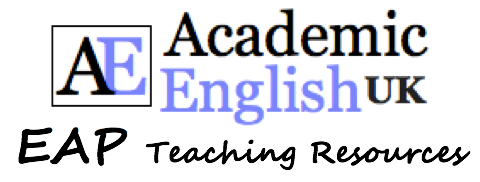
EAP Writing Error Correction
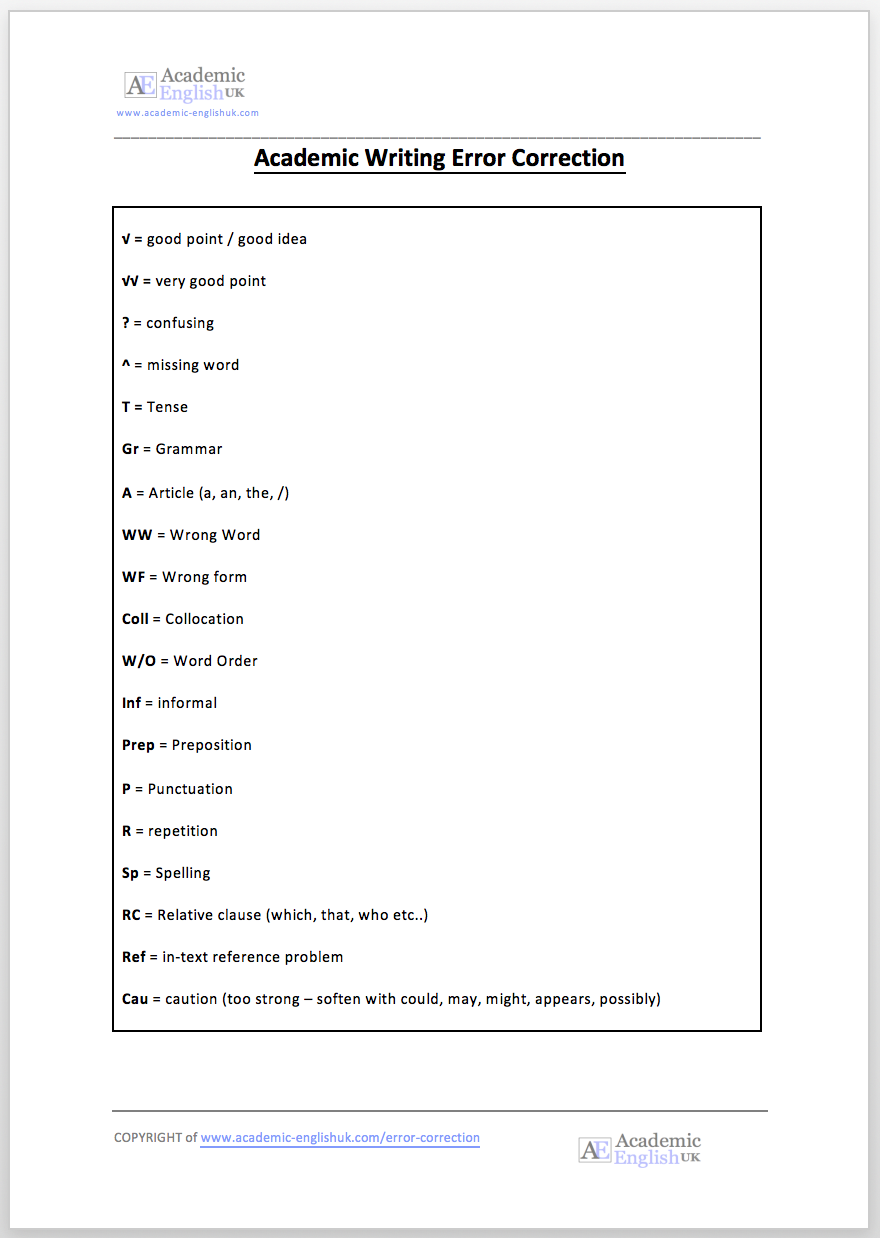

IMAGES
VIDEO
COMMENTS
Ask the learners to correct the mistakes on it using the code. Set the writing task, either as homework or in class. Ask learners to write double-spaced or leave a large margin. Collect the work and correct it using the correction code. Underline the mistakes you want learners to notice and add the codes, either underneath or in the margin.
A writing correction/editing code is a set of rules and symbols that instructors can use to assess students' pieces of writing in order to elicit corrections rather than provide them. Using correction codes is considerably effective in teaching ESL/EFL writing. MacDonald (2020) investigated the effectiveness of different writing corrective ...
Correction: He is feeling bad today. Adv erb missing or faulty adv: He doesn't write very good. Correction: He doesn't write very well. agr Agreement faulty 1. Subject-verb agr: There wasn't many students in class today . Cor: There weren't many students in class today. 2. Pronoun-antecedent Agr: If one is to succeed, you must work hard.
Here are the most useful 10 symbols you could put on your students' writing in order to help them notice their mistakes. 1. SP. This indicates a spelling mistake in a word. 2. WO. If students write words in the wrong order, such as an adjective after a noun ( house big instead of big house ), write WO to indicate the problem. 3.
This is a 3-way system. 1) Tutor marks the mistakes using the correction code and returns to the student. 2) Student makes correction in a different colour pen and returns to the tutor. 3) Tutor checks the corrections and returns to the student. Reason: This way the student learns from their mistakes and takes more responsibility in correcting ...
Memorize the Proofreading and Editing Signs. Proofreading refers to reviewing one's written works and correcting errors using different paragraph editing symbols or notations. For example, the letters "lc" represents the editing symbol for lowercase. The closing bracket means you need to move your text to the right.
Writing Correction Codes Code Use Example WW Wrong word As our plane flew on the mountains, we saw snow. WT Wrong time As our plane flew over the mountains, we see snow. WF Wrong Form As our plane flew over the mountains, we was seeing snow. WO Word order As our plane over the mountain flew, we saw snow. SP Spelling As our plane flue over the mountains, we saw snow.
Writing correction code. Use the following symbols to understand the mistakes you have in your writing and to help you correct the mistakes yourself. Sometimes you won't know the correct form, so ask your teacher if you're not sure. SYMBOL - MEANING. S - Incorrect spelling.
1.2 GETTING STARTED: Using Correction Codes. Before you begin writing, it's useful to establish some basic ways to communicate with your instructor about your work. Many instructors use special correction codes, such as those listed the table below, to provide you with quick and efficient feedback about errors in your writing. For example ...
Correction Symbols Below, you will find common symbols that your instructors may use to indicate errors in your writing. Also, keep in mind that your instructors may use additional symbols that are not on this sheet. We suggest that you discuss these symbols with your instructors if you are unsure what they are asking you to correct. Correct
Correction codes are standardized symbols or abbreviations used to indicate and rectify specific types of errors in written text. They provide a concise and efficient way to identify and address mistakes, allowing writers to improve the accuracy and clarity of their work. These codes are important for several reasons: Precision: Correction codes enable precise identification
Awkward Phrase. Grace Fleming. The "awk" indicates a passage that seems clunky and awkward. If the teacher marks a passage as awkward, you know that they stumbled over your words during their review and became confused about your meaning. In the next draft of your paper, be sure to rework the phrase for clarity. 04.
Whether it's incorrect spellings, missing punctuation, or an extra words, these symbols cover the most common mistakes that appear in children's writing. Display this poster in your classroom, or give one copy to each child, so that they can decipher and improve upon your corrections. Be sure to check out our Proofreading Teaching Wiki to help ...
Do you correct students' writing or help them to correct their own work? Using a correction code can help learners become more autonomous. Find a...
Teaching English as a Foreign Language For Dummies. Explore Book Buy On Amazon. Most teachers use a correction code when they mark written work so that the student can do some self-correction. You can devise your own symbols but this table shows some possibilities.
Wrong form: And the BEST things is that these SYMBOLS are introduced, and you think only ABOUT this film…. 00 BRITISH 00 COUNCIL TeachingEnglish . Title: Microsoft Word - Writing correction code (with answers).docx Created Date:
Writing Center Correction Symbols AC Adjective Clause/Adjective Phrase (Relative Clause) error-You need to add, remove, or edit an adjective clause or phrase. For example, the sentence "I saw a man shouted at me" should be "I saw a man who shouted at me" or "I saw a man shouting at me."
Leave a space where this mark is inserted. You'll find it if you write "for awhile" instead of "for a while" or "eventhough" instead of "even though". ¶ = the "paragraph" mark. Probably means "Begin a new paragraph here" but may also mean "You call this a paragraph?" = the "dele" or delete symbol. Correction Symbols Used . Correction Symbols
Correction symbols / codes refer to the indication of types and locations of students' mistakes through the use of correction codes such as those suggested by Oshima and Hogue (1997). The application of correction codes is ―normally done by underlining the ... The process of correcting their writing using the correction symbols provided by ...
Teachers: This code can be used to correct student's work. Underline the mistake and use one of the symbols to indicate problem. Students correct the mistake using the code and return to teacher to check .
symbols for these mistakes in the margin. Then students are able to self correct these . ... impact of w ritten correction codes on the writing performance among ESL students and .
Notation 1. A code Ccan be defined for the following notation [n,k,d] q, where the length of a codeword cis n, the dimension of the code is k, the minimum distance of the codes is d, and the alphabet size is q= |Σ|. 1.2Types of noise ECCs are built to correct errors that arise when noise acts on our data while transferring it. The